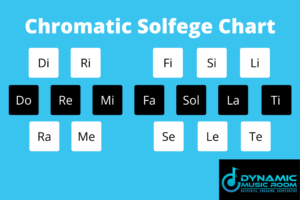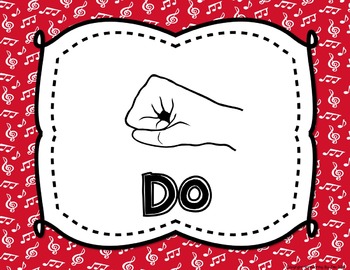

Given all that, I suspect there are three potential answers to my quandary:ġ. On the other hand, it feels naive to "switch keys" in my head to whatever chord is being tonicized in the moment, and is moreover a difficult thing to predict when attempting to sight-read/sight-audiate a harmonically complex piece. I'd hear V/V in C major as re-fi-la, with "fi" being the solfege syllable for #4), but this becomes very difficult when relatively remote chords such as the major chord on the seventh degree are tonicized. In music school, I was a big fan of Schoenberg's "Structural Functions of Harmony," which puts forth a pretty expansive notion of how even remote key areas still relate to the governing tonic of the piece, and so it's tempting to try to understand such passages in terms of the "original" key, using chromatic solfege syllables (e.g.
#Chromatic solfege how to#
My question concerns how to audiate melodies and harmonies when the tonal center changes rapidly, either because of a rapidly modulating tonal center (like you see in early Schoenberg) or because of a brief tonicization of a secondary harmony. This works really well for me when the tonal center in question is pretty stable, even in the presence of chromaticism, and I've practiced it to the extent that I can compose homophonic four-voice harmonic progressions as well as various species of counterpoint exercises (in two voices) in my head when I'm on the train or before I go to sleep. I learned to do this by hearing in terms of moveable-do solfege syllables, so for example if I'm hearing a blues on the radio I'll hear the bass line moving from do, to fa, to do, to sol, then to fa, etc. Don't worry too much about this chart if you're just getting started with solfege and are looking for the basics only.So, I'm a musician who believes very much in the value of audiation: that is, not only hearing pitches in my head, but also hearing them in terms of both the current harmony and the current tonal center. This will cover every note possible in a scale that is possible, including accidental notes. Here's an advanced scale that takes into account each note in a chromatic scale.
#Chromatic solfege professional#
This works well for groups of singers and young students in voice lessons that are learning how to sing through scales with a professional teacher. You will need to also refer to the chromatic solfege chart below to account for accidentals.Ĭheck out this chart if you're looking to take things to the next level with hand signals. If you use fixed do, you will stick with these notes no matter what key you're singing in. The most common music scale is the key of C major. Here's a chart you can use to get used to seeing how the scale matches with a specific key. Most people use moveable do since it's easier to grasp with a variety of different song keys. If not, you should assume that you are starting with C as the first note of the scale. Note that if you're using "movable do", the first note ( tonic note) in this scale can be whatever note you want it to be. This is a basic chart that you can start with as a beginner. Related Post: Why Are There Only 7 Notes In An Octave? Simple Solfege Chart If you are in "movable do, " your "do" can be C, C#, F, Bb, or any other starting note. That means if you are singing in a key that isn't C, you will need to use chromatic solfege from the last chart below. Note: In the "fixed do" method, your "do" will always be C.
#Chromatic solfege pdf#
You can download each chart as a PDF for free, in addition to studying it here on my site.

It's time to impress your music teachers and your future fans with your knowledge! Check out these charts I've made below that can help you learn and memorize your solfege. The good thing is that no matter if you're using "fixed do" or "movable do", the solfege names and hand signals remain the same and can help you with all types of scales from major, to minor, to Mixolydian.

Don't feel bad for looking for a cheat sheet solfege can be difficult to learn when you're a beginner just getting into the music world.


 0 kommentar(er)
0 kommentar(er)
